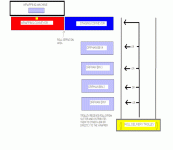ALL REPLIES IN BLUE...
Here are the machine steps:
1. the slitting machine cuts 5 rolls off a large roll they are 10",20",30",40"an 50".
Referring to Step-2, the following question occurs regarding Step-1...
Does the slicer cut 5-rolls of 10", OR 5-rolls of 20", OR 5-rolls of.... etc?
-or- , combinations?
It can be a combo of various widths, the roll size beginning at the slitter is 200" which will be cut down to whatever the end user defines. 10" to 200" if need be, it is even bossible to have 20 10" cuts.
We can't see the machine, we don't know the details and we certainly don't know what you know! --Unless you tell us!
2. The rolls are then transported to the wrapping machine trolley, where the operator will enter the lengths of each cut on an OIT. The OIT will allow each roll to either be sent directly to the wrapper or staged in an orphan bin to be wrapped together later with other same size rolls.
I don't see a "Wrapping Machine Trolley" in your figure. Could you be referring to the "Roll Delivery Trolley"?
Is this a case of, the "Trolley" has a set of rolls, of various widths, and the operator needs to enter, in the proper order, the sizes of the rolls that are on the trolley? Which raises the question I asked at Step-1... What kind of combinations might we expect to see?
"Wrapping Machine Trolley" = "Roll Delivery Trolley" just thought it would define the funtion easier. the operator will enter the cut (amount and size) on the OIT. this will tell the trolley where to go. He will then need to enter the size just before the roll enters the "wrapping conveyor" via thumbwheel..
3. lets say the 10" roll will go to orphan bin #1 and wait until another 10" roll is cut.
What waits? And what exactly is it waiting for?
the 10" roll waits for another 10" roll from the next set of cuts made from the slitter 200" roll. it will process the rest of the rolls 20, 30, 40 and 50. then go back to pick up another whole set from the slitter and drop of the 10" with the others.
process the 20-50" again and then go get the 2 10" rolls to be processed prior to starting the whole operation again.
4. The other 4 rolls go directly to the wrapper and are wrapped separately. In order from small to big.
Huh??? What criterion do you use for determining what goes where? What is your general scheme? (Please describe, more specifically than you have 'til now.)
at the OIT the rolls are assigned "groups" group 1 may be 1 20" roll to go directly to the wrapper, and group 2 is 1 30" to go directly to the wrapper. 3, 4, and 5 would be 30, 40, 50.
group 6 would be the 10" in the orphan bin waiting for the next 10". orphan bins have a data entry point allowing the operator to input how many rolls would be considered a bundle, in this case 2 10" rolls.
5. Just before the roll enters the wrapping conveyor, the operator will enter the length on the thumb-wheel 20. 30, 40, or 50.
Since you indicated in Step-4 that there may be a few different sizes wrapped "In order from small to big.", then... does the operator have to key-in as wrapping is done?
just before the roll enters the wrapper the operator can change the thumbwheel data, he will the press the "start" button which will move this vale into the register that sets the "split timer" and the centering timer"
split timer is used to seperate rolls on the staging conveyor, remember the 20, 30...... have all been discharged onto the staging conveyor. so the staging and wrapping conv will jog fwd, the stage will stop at the timer dn bit and the wrapper convey will continue on it way.
6. It will then jog the staging and wrapping conveyor fwd for a short period decided by the thumb-wheel.
What is "It"? And, what makes "It" decide to jog?
see above.




